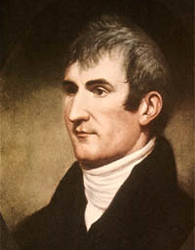Along with William Clark, Meriwether Lewis led the first expedition through the territory of the Louisiana Purchase, revealing the landscape and nature of the American West. Although his life was short, his contributions to the exploration of America are priceless.
Meriwether Lewis’ Early Days
Meriwether Lewis was born on August 18, 1774, in Albemarle County, Virginia, the second child of Lucy and William Lewis. When Meriwether was 5 years old, his father passed away and his mother remarried, moving the family to Georgia.
Meriwether’s adventurous spirit was evident even at 8 years old, when he frequently went hunting late at night in the bleakness of winter. He also developed a lifelong passion for natural history, nurtured by his mother’s knowledge of medicinal herbs.
Lewis returned to Virginia at age 13 to attend school. He thought about attending the College of William and Mary but instead chose to run the family estate at Locust Hill. At age 20, he joined the U.S. Army and rose to the rank of captain six years later. He served in Ohio and Tennessee, gaining valuable frontier life experience.
Sources in this Story
- Virginia Center for Digital History: Meriwether Lewis
- PBS: The West: Meriwether Lewis
- Library of Congress: Jefferson’s Instructions for Meriwether Lewis
- Idaho Public Television: Lewis & Clark In Idaho: Historian Gary Moulton
- National Geographic: Lewis & Clark: The Journey Begins
- Smithsonian Magazine: Lewis and Clark: The Journey Ends
- The Seattle Times: Some Push Murder Theory In Meriwether Lewis’ Death
The Lewis and Clark Expedition
In 1801, President Thomas Jefferson, a family friend, asked Lewis to be his personal secretary, with the intention for Lewis to eventually lead an exploration of the American West. Lewis, who had long desired to participate in Jefferson’s proposed expedition, accepted. To adequately prepare for his journey, Lewis studied navigation, astronomy and botany at the University of Pennsylvania.
In April 1803, the United States purchased roughly 828,000 square miles of mostly unexplored western territory from France for $15 million. On June 20, 1803, Jefferson, having received $2,500 in funding from Congress, wrote a letter to Lewis providing instructions for the exploration of the Louisiana Purchase.
Lewis felt he needed a partner for the journey so Jefferson granted permission for William Clark, Lewis’ friend and former commanding officer, to join the expedition. Clark was a more gregarious and rugged figure than the moody, cerebral Lewis, though their personality traits were likely exaggerated to distinguish them, says Gary E. Moulton, editor of “The Definitive Journals of Lewis and Clark.”
The Corps of Discovery expedition, consisting of about 45 men, set out on the Missouri River on May 21, 1804, and made its way to North Dakota where they built a fort to spend the winter. The expedition members spent a busy winter at Fort Mandan, trading with the Indians and hiring Toussaint Charbonneau, an interpreter. Charbonneau’s Shoshone wife, Sacagawea, and her infant son, Jean Baptiste, would accompany the expedition westward.
Lewis led the group through the rugged terrain of the Columbia River to the most western coast of the country. The expedition came to an end near present-day Astoria, Oregon, in November 1805. On March 23, 1806, Lewis advised the party to pack up and head for home.
The expedition returned to St. Louis in September 1806, with journals providing an account of their journey for President Jefferson. Their excursion marked an original pathway through the western territory, opening up greater opportunity for expansion.
The full text of the Lewis and Clark journals, as edited by Gary E. Moulton, is available online.
The Rest of the Story
In March 1807, Jefferson made Lewis governor of the Territory of Upper Louisiana. But Lewis fell into debt and never received reimbursement for his expenses. “Severely depressed, Lewis attempted suicide twice” on his way to Washington, D.C., to clear his name, Smithsonian Magazine reports.
On October 10, 1809, he stopped at an inn on the Natchez Trace in Tennessee. Late that night, two gunshots were heard from his room and Lewis was found dead in an apparent suicide. Lewis’ family insisted that he was murdered, and scholars and historians continue to debate the details of his mysterious death.











